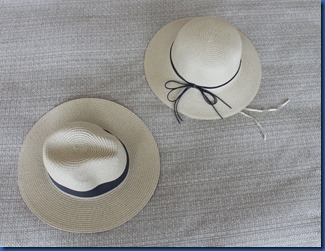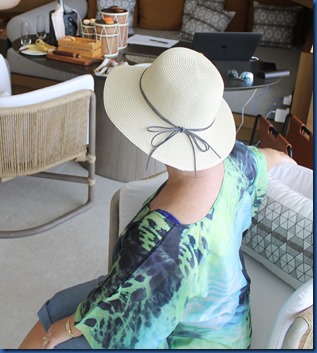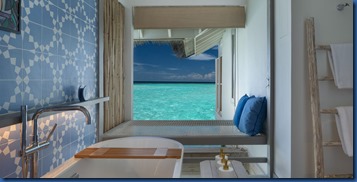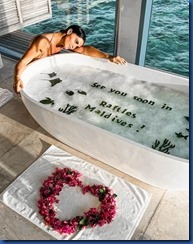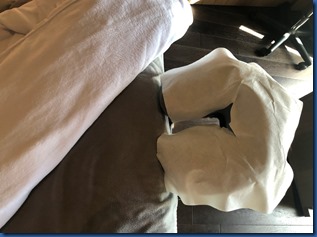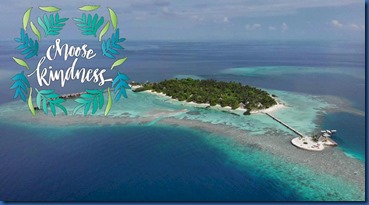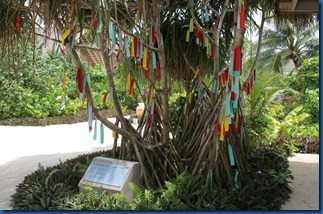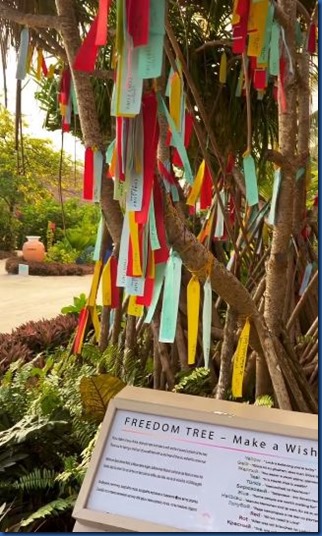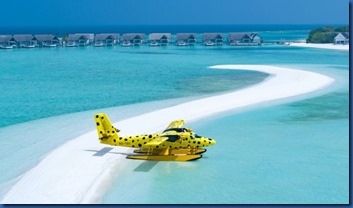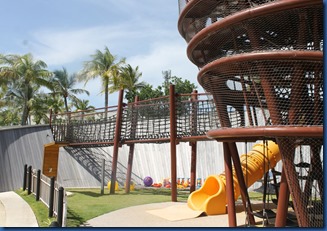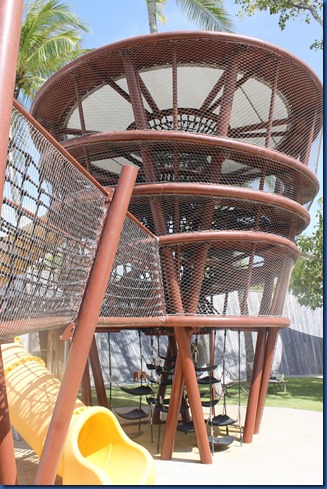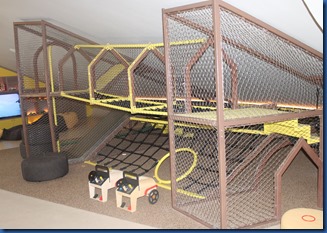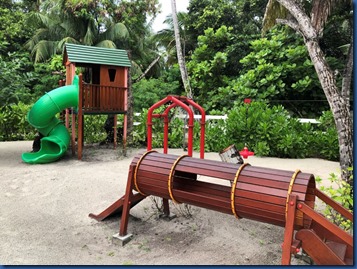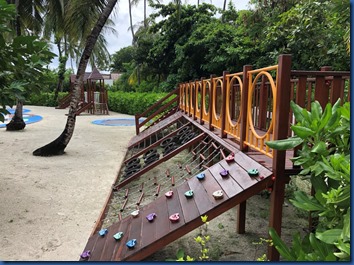Ritz Carlton Maldives’ villas offer their own way of shading from the sun if you want to stay outdoors with his-and-hers sun hats in every room.
Best of the Maldives: Bathroom Hammock – Cora Cora
All the outdoor amenities in the Maldives are a true delight, but sometimes you do need a break from the tropical sun bearing down on you (especially for us anglo-complexioned). If you want to escape the brightness, but still like the idea of lounging in a hammock over the ocean, Cora Cora has installed them in their outdoor bathrooms. (top tip: the hammocks are also an excellent place to lay out wet swim suits and snorkeling gear to dry with less worry of a gust of wind blowing them into the sea which you have when setting them out on the deck).
Best of the Maldives: Bath Decorating Palm Letters – Raffles
Raffles has its own distinct font for its bath decorating to make its sudsy welcome even clearer (thanks Paola).
Best of the Maldives: Spa Softness – Ritz-Carlton Maldives
A spa treatment, especially in the Maldives, isn’t just about the targeted part of the body, but is also an immersive experience of relaxation and comfort. With massages, I do sort of appreciate a lovely location, but frankly when you are face down with your eyes closed, there is not much opportunity to enjoy them. So for massage treatments, the sensory luxury is all about touch – the feel of the plush table and of course the expert therapists.
Ritz Carlton Maldives’ spa simply exudes sensual softness in every details. You change into super silk soft robes. The face rest not only featured a spongy cushion, but also it was covered with an ultra soft chamois. The same chamois texture that covered the entire bed. And Dankaj, my masseur, provide a treatment that was fluid and tender while being firm enough to coax the tight muscles out of their tension (I find male masseurs to often be too mechanical and firm) with just the right pressure like the right amount of chili in a curry.
Best of the Maldives: Kindness – Nika
- “Practice random kindness and senseless acts of beauty.” —Anne Herbert
Anne Herbert’s quote above seems to capture the ethos of Nika’s “kind island” initiative:
- “NIKA ISLAND will be the first kind island in the Maldives…An island not subject to the ravages of time, nor to the dynamics of massive tourism that are redefining the Maldives. A land that embraces the value of kindness by translating it into concrete social projects that benefit the ecosystem itself: an ambitious alchemical experiment with simply unrepeatable contours. International Kindness Movement is a network that to date has reached 300,000 participants and spreads kindness, restoring the highest human, spiritual, cultural, environmental and social values to the territory in which it operates, through the promotion of a healthy and conscious lifestyle.”
Nika is becoming an Ambassador of Kindness as a part of the International Kindness Movement which describes them in their charter as follows:
- “The Ambassadors of Kindness are: Friendly, Understanding, Positive, Kind, Inspirational, Grateful, Compassionate, Resilient, Passionate, Patient, Empathetic, Respectful, Determined, Forgiving, Humble, Honest, Courageous. As an Ambassador of Kindness, you will be undertaking to support the ongoing kindness campaign. Whilst it is about the promotion of events leading up to World Kindness Week in November, it’s also about engaging the whole village to create a better environment within the greater community by promoting the good work that is being done in all sectors of the Village.”
Some of this might seem rather obvious and superfluous (isn’t every resort going to be “kind”), but I think that just mission statements and campaigns can inspire and focus organisations to make that extra effort and take those extra initiatives to walk the walk.
My kind of island!
Best of the Maldives: Freedom Tree – Cora Cora
Another variation of the wish tree is Cora Cora’s “Freedom Tree”. Not only do you write you wish to hang on a special walking tree for them to be lofted away by the Maldives ocean breezes, but you can also choose one of 4 colours each associated with one of the following sentiments:
- Yellow = “Luck is believing you are lucky”
- Teal = “It is health that is wealth”
- Blue = “Some people are worth waiting for”
- Red = “All we need is love”
Best of the Maldives: Box Fish Seaplane – Four Seasons Landaa Giraavaru
Four Seasons Landaa Giraavaru adds another creature to the school of flying fish is the Maldives skies introducing its boxfish styled seaplane (to join the whale shark, yellowfin tuna, shark, and parrot fish).
Best of the Maldives: Kids Zip Line – Soneva Jani
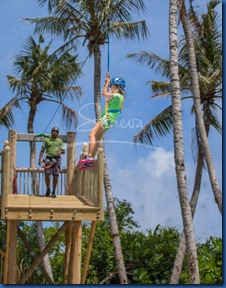
Photo credit – Haneen @haneensiddiq
Another “Finally Seen”, in fact one of my earliest. Coincidentally, Lori gave me a 60th birthday gift of a trip to Belize partly motivated by its similarity to the Maldives. One of the activities on the agenda was a zipline through the rain forest. Soneva Jani’s now offers that high flying thrill for kids at its “The Den” facility.
Zipitty doodah day!
Best of the Maldives: Rope Climbing – Ritz-Carlton Maldives
Ropes courses are a classic team building activity in the corporate world, and for those budding executives, Ritz Carlton Maldives’ “Ritz Kids Club” offers and indoor and outdoor net-protected rope climbing (and clambering) frame. With the number of these “Climbing” features going higher and higher, I’ve added a tag for them with this post.
Best of the Maldives: Obstacle Course – Emerald
For all the budding young Gladiators looking to burn all the excess energy of from the excitement of arriving in paradise, Emerald’s Dolphin Kids Club offers a fun obstacle course to scamper through for hours on end so when Mom and Dad pick them up they are all spent and ready to sit calmly during cocktail hour.

